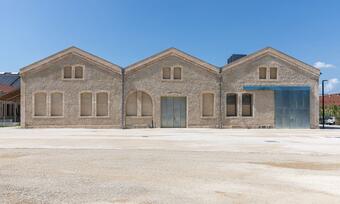This highly sustainable and ecological building, called Atelier Luma, is the latest addition to Luma Arles, a vast contemporary art campus founded by Swiss billionaire and patron Maja Hoffmann, heir to the global healthcare company Hoffmann-La Roche, which operates in the pharmaceutical and diagnostic sectors.
19th-century sheds transformed into exhibition halls Hoffmann opened a 10-hectare park in 2021, and it all started with a tower of sculpted metal structure by the famous Frank Gehry.
Underneath the tower is a former concrete surface transformed into a lush oasis, and a group of 19th-century sheds has been converted into exhibition halls.
The Atelier is the final piece of the puzzle and the "quietest" element of all, serving as a living demonstration of how bio-architecture can boldly look to the future.
The project involved a team of thirty researchers; Photo: Joana Luz It's time to shift from global, extractive supply chains to regional material ecosystems that help regenerate the environment.
With the idea of continuing her father's work, a pioneering naturalist who fought to preserve the marshland of the Camargue and co-founder of the World Wide Fund for Nature, Maja Hoffmann sees Atelier Luma as a way to achieve that.
"I wanted to continue the preservation work, but without being a proponent of green conservatism. Action is needed," said Maja Hoffmann to The Guardian.
Highlighting that the built environment is responsible for about 40% of CO2 emissions, Atelier Luma's artistic director, Jan Boelen, pointed out that it is time to embrace local and organic construction methods and to shift from global, extractive supply chains to regional material ecosystems that help regenerate the environment.
Boelen adds that "where others see waste, we see opportunities".
From algae dyeing to sunflower-based products The whole process started with mapping the resources, industries, and waste products of the region in question. A team of thirty researchers from product design, chemistry, sociology, biology, economics, and engineering explored all aspects, from algae dyeing to sunflower-based products.
After extensive testing and certification, many of the experimental materials were used in actual construction.
The conversion of the stone industrial shed into the studio home was a joint effort of the London collective Assemble and the Belgian practice BC Architects. These two firms were initially engaged to compete for the project, but they decided to join forces and collaborate to do the job better.
"We saw the building itself as a quarry. Broken roof slates were reused on the floor, incorporated into polished terrazzo, to form a kind of history of the building engraved into the ground," said Laurens Bekemans from BC Architects, adding:
"The internal walls are made of rammed earth, using a recipe that uses rubble and limestone powder from nearby quarries mixed with white clay to create a concrete finish similar to the original concrete but with very little embedded carbon."
5,000 tons of clay turned into applied ceramics Certain oversized elements give the space a dollhouse-like atmosphere. Maria Lisogorska from Assemble explains how the long, two-story wooden gallery was inspired by the Teatro Oficina Line Bo Bardi in Sao Paulo, bringing a somewhat theatrical look to the space, and interestingly, this wooden structure is painted with natural deep indigo blue colors.
Indigo is one of the plants grown in the outdoor garden, along with cacti used to grow Cochineal bugs, used for the red color, while the whole system is maintained using recycled wastewater and "yellow water" from toilets, which is safely filtered through an algae cleaning process.
Rice fibers are woven into ropes to make geotextiles, which help mitigate coastal erosion. Also, invasive species, such as Japanese knotweed, have been turned into cellular-structured tiles, which are veneered with other invasive wood for making furniture.
While the doorknobs are made of salt collected from the surrounding marshes, with the idea of fighting microbes, about 5,000 tons of clay produced by the quarry have been turned into applied ceramics.
Materials are heavy, so they should stay local. People and ideas are light, so they should travel.
Although rooted in the Camargue, the studio has international ambitions, applying its bioregional principles to other contexts, and some projects are currently underway. Boelen's philosophy in this context is as follows:
"Materials are heavy, so they should stay local. People and ideas are light, so they should travel."
Although most of the funding comes from Hoffmann, the studio also operates as a revenue-generating consulting firm. In this regard, Boelen emphasizes that they are currently working with a champagne brand, exploring how grape waste could be used for packaging, as well as with, as he puts it, "a major European automotive group," but he was currently unable to go into details about that collaboration.
Gehry's lighthouse as bait for the audience It is interesting to mention that the ten-story, €175 million Gehry lighthouse now stands in contrast to the new project and generally sharply opposes Hoffmann's declared aesthetics. However, she hired Gehry 15 years ago, but also emphasizes that such a "sculpture" was needed to attract people's attention.
However, the combined effect of Gehry on the one hand and Assemble and BC Architects on the other makes Luma Arles a fascinating case study. There are few places in the world where it is possible to see the end of one outdated architectural era and the optimistic beginning of another so clearly.


